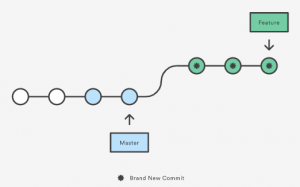

Instead, they push the feature branch to the central server and file a pull request asking to merge their additions into main. Once someone completes a feature, they don’t immediately merge it into main. Pull requestsĪside from isolating feature development, branches make it possible to discuss changes via pull requests. Merge from the pull request in Bitbucket.
#Feature master git code
When your pull request is approved and conflict-free, you can add your code to the main branch. Merge your pull requestīefore you merge, you may have to resolve merge conflicts if others have made changes to the repo. Resolve their comments locally, commit, and push the suggested changes to Bitbucket. Now teammates comment and approve the pushed commits. To get feedback on the new feature branch, create a pull request in a repository management solution like Bitbucket Cloud or Bitbucket Data Center. From there, you can add reviewers and make sure everything is good to go before merging. After setting up the tracking branch, git push can be invoked without any parameters to automatically push the new-feature branch to the central repository. This command pushes new-feature to the central repository (origin), and the -u flag adds it as a remote tracking branch. This serves as a convenient backup, when collaborating with other developers, this would give them access to view commits to the new branch. It’s a good idea to push the feature branch up to the central repository. Git status git add git commit Push feature branch to remote This guide assumes this is maintained and updated in the main branch.

Start with the main branchĪll feature branches are created off the latest code state of a project. The following is a walk-through of the life-cycle of a feature branch. Of course, this is also a convenient way to back up everybody’s local commits.

Since main is the only “special” branch, storing several feature branches on the central repository doesn’t pose any problems. This makes it possible to share a feature with other developers without touching any official code. In addition, feature branches can (and should) be pushed to the central repository. Git makes no technical distinction between the main branch and feature branches, so developers can edit, stage, and commit changes to a feature branch. The idea is to give a clear, highly-focused purpose to each branch. Feature branches should have descriptive names, like animated-menu-items or issue-#1061. Instead of committing directly on their local main branch, developers create a new branch every time they start work on a new feature. The Feature Branch Workflow assumes a central repository, and main represents the official project history. The Gitflow, and Git Forking Workflows traditionally use a Git Feature Branch Workflow in regards to their branching models. The Git Feature Branch Workflow can be incorporated into other workflows. Git Feature Branch Workflow is branching model focused, meaning that it is a guiding framework for managing and creating branches. We discussed other Git workflows on the Git workflow overview page. The Git Feature Branch Workflow is a composable workflow that can be leveraged by other high-level Git workflows. The point is, pull requests make it incredibly easy for your team to comment on each other’s work. Or, if you get stuck in the middle of a feature, you can open a pull request asking for suggestions from your colleagues. They give other developers the opportunity to sign off on a feature before it gets integrated into the official project. It also means the main branch will never contain broken code, which is a huge advantage for continuous integration environments.Įncapsulating feature development also makes it possible to leverage pull requests, which are a way to initiate discussions around a branch. This encapsulation makes it easy for multiple developers to work on a particular feature without disturbing the main codebase. The core idea behind the Feature Branch Workflow is that all feature development should take place in a dedicated branch instead of the main branch.


 0 kommentar(er)
0 kommentar(er)
